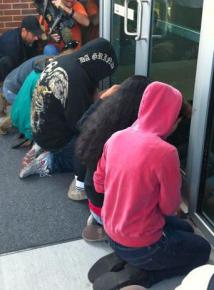Injustice drags on in Florida
, and report on new protests in Sanford as the legal case against George Zimmerman takes another turn.
AS DEMONSTRATORS returned to Sanford, Fla., on April 9 after a three-day march to demand justice for Trayvon Martin, the special prosecutor appointed by Florida's Republican governor said she wouldn't convene a grand jury to decide whether to charge Trayvon's killer, George Zimmerman.
State Attorney Angela Corey said she could seek the charges herself, and so convening a grand jury wasn't necessary. But the announcement leaves anti-racist activists still wondering when and if Zimmerman--the self-appointed neighborhood watch captain who spotted Trayvon in a gated community, stalked him, and eventually shot and killed him--will be arrested.
The urgency of that anger was conveyed by a demonstration in front of the Sanford police headquarters as Corey's decision was made public. Some 40 people, including participants in a 40-mile march last weekend from Daytona Beach to Sanford, blocked the doors throughout the day in an act of civil disobedience.
Police officials kept the building closed during the demonstration, and City Manager Norton Bonaparte Jr. and Acting Police Chief Darren Scott met with several people from the protest.

IN THE media, there were conflicting opinions about the meaning of Corey's decision not to convene a grand jury. Some predicted that an arrest would therefore come soon, others suggested the prosecutor didn't want to file charges at all, and still others speculated about whether Corey was dragging her feet to keep the media spotlight on herself to further possible political ambitions.
Benjamin Crump, a lawyer for Trayvon's family, told CNN:
We were anticipating that there would be no grand jury, because the family has always been hopeful that there would just simply be an arrest. We believed, from day one, that they had enough evidence to arrest the killer of Trayvon Martin, and now, as the evidence has continued to unfold, we think there has been a plethora of evidence to simply effect probable cause to do an arrest.
This goes to the heart of the matter for the millions of people who want to see justice for Trayvon--whatever Angela Corey has decided about a grand jury, the arrest of George Zimmerman is already long overdue.
If the roles had been reversed on February 26 in Sanford--if Trayvon, a Black teenager from out of town, had killed Zimmerman and claimed self-defense--no one would seriously expect the police chief and prosecutor to decide against arresting him.
But that's exactly what Crump says happened on the night Trayvon died. In a letter to the U.S. Justice Department, Crump charges that Sanford Police Chief Bill Lee and the original prosecutor on the case, State Attorney Norm Woflinger, met hours after the shooting and decided not to have Zimmerman arrested--against the recommendation of the lead police investigator, according to Crump.
Wolfinger later set April 10 as the day that a grand jury would begin hearing evidence in the case to decide if charges should be filed. But Wolfinger then recused himself after criticism mounted about not charging Zimmerman and the slow pace of the investigation. This is the grand jury that Corey said would not be used.
Meanwhile, in a bizarre twist that adds insult to injury, George Zimmerman has launched a website to raise money for himself--and the site features a photo of graffiti reading "Long live Zimmerman" that was spray-painted on the wall of the Black Cultural Center at Ohio State University in an act of racist vandalism.
When news of the website, which was launched last weekend, emerged, many suspected it was a hoax--but lawyers for Zimmerman confirmed its authenticity to several media outlets. Later on in the day on Monday, the website was inaccessible.
THE MARCH to Sanford last weekend was organized a new network of activists calling itself the Dream Defenders that is composed of students from Florida's state university and college system, with backing from local A.M.E. churches. The journey from Daytona Beach to Sanford was inspired by the famous Selma to Montgomery march during the civil rights movement, according to organizers.
After covering between around a dozen miles each day, the marchers reached their destination in Sanford, the Allen A.M.E. Church, on Sunday evening.
The next morning, some 40 Dream Defenders and supporters marched from the church to the police building, where they blocked the front doors. Demonstrators said their demands included the arrest of George Zimmerman, the firing of Police Chief Bill Lee and an investigation of the Sanford Police Department.
The crowd was hopeful and defiant, with speakers addressing protesters about the facts of Trayvon's case, but also the systematic inequality present in U.S. society, and what must be done to fight it.
The day's news--about Corey's decision not to hold a grand jury--was at the forefront of people's minds. Asked about the possibility that Zimmerman wouldn't be arrested at all, Nailah Summers, a philosophy student at University of Florida, responded, "If Zimmerman doesn't get arrested, if that doesn't tell people that there's no justice for communities of color, I don't know what will."
Paris Baker, a 23-year-old actor and resident of Sanford, spoke of racial tension in town: "People feel like they're walking on needles. It feels tense to be in a public place with white people." Still, Baker said, in spite of "the fiasco and the pain, I'm very encouraged by how many young people got involved."
After the rally, Terell DePina, a business administration major at Florida A&M, summed up the stakes in this struggle against racism: "America has to be held accountable. When will America begin practicing what it's preaching?"


